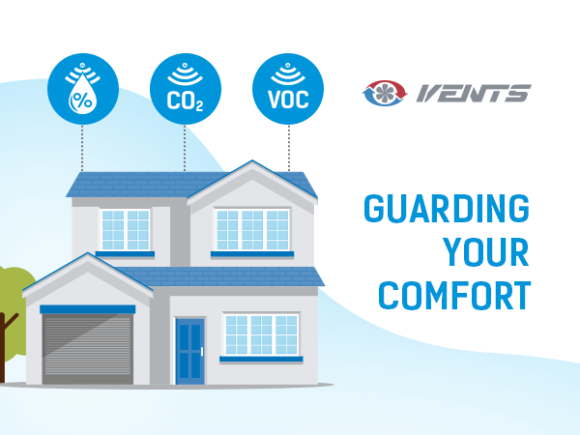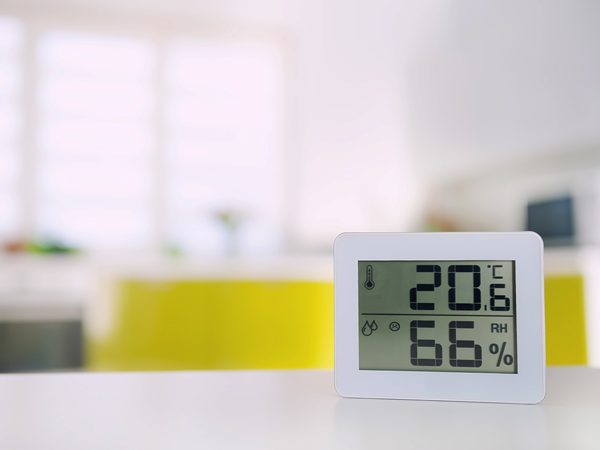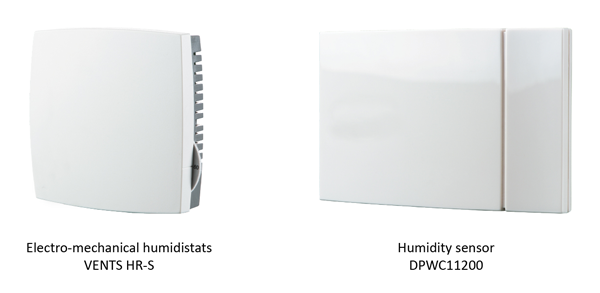How to ensure healthy air at home? Part 1
Modern residences and apartments are airtight premises furnished with furniture, various home appliances and office equipment, carpets and other household items. Such an environment provides comfortable, but not always safe living conditions. Air in such premises fairly quickly becomes moisturized and absorbs a large amount of volatile organic compounds originating from different sources. Moreover, any person present in such premises actively fills the air with carbon dioxide by simply breathing, which together with other factors significantly decreases the quality of the air indoors and in the long run poses a serious threat to health. Modern ventilation systems provide a solution to this problem by ensuring proper air exchange. Such systems are guided and prompted to operation and to selection of proper operation mode by air quality sensors. In this series of articles, we will talk about such sensors in more detail.
What does “comfort at home” and “cosiness” mean to us? Well, for starters, it probably means warmth, which is especially important during the cold season of a year. That is why modern insulated glazing is so popular among people and is used almost in each building because it shields our homes from outside cold air and harsh weather. However, it so happens that sometimes when we gain advantages in something, we also lose at the same time in sьomething else. Insulated glazing make our homes very airtight. In terms of saving heat, it is certainly a plus, but in terms of ventilation – it is a significant disadvantage. Insufficient ventilation and constant presence of people in a room makes air there unsuitable for proper dwelling very quickly because oxygen content decreases and carbon dioxide increases, it becomes more humidified and various odours and unwanted impurities appear.
Naturally, such air even in the warmest building cannot provide its residents sufficient comfort and cosiness, and something must be done about it. But how can one solve a problem that they cannot see or feel? After all, a person can feel with its body if the temperature is out of the comfortable range and do something about it, but when it comes to air quality, things get a bit more complicated. In most cases, one cannot recognize bad air quality until headache appears and overall wellbeing worsens. How do we identify the level of air pollution and the moment when we need to do something about it? Now this is the task of sensors designed for controlling such air parameters as humidity, concentration of carbon dioxide, volatile organic compounds, etc.
Part one: Humidity and humidity sensors
This is one of the main parameters of the microclimate in a room. Relative humidity is increased due to vapour generated when cooking, taking a bath or a shower, and when room temperature decreases (it often happens in autumn before the heating season starts and in spring after it ends). Any person is also a source of humidity that they generate through breathing and by evaporation of liquids from the body, which in turn also contributes to an increase of vapour concentration in the air. In an insufficiently ventilated premises, humidity level is constantly increasing and it leads to problems for people who dwell there.
Among such problems we should highlight appearance and spread of mould (fungi). Relative humidity above the normal value (over 60 %) and under moderately warm temperatures (from +18 to +25°С) creates ideal conditions for reproduction of these harmful microorganisms. Small and almost inconspicuous mould stains in places of increased humidity may lead to serious health problems. Mould discharges a large amount of spores sized 2–8 µm into the air, which when entering lungs cause an allergic reaction and may lead to a number of illnesses such as rhinitis, pharyngitis, bronchitis, asthma episodes, etc. The products of mould metabolism come as strong poisons that can cause poisoning, development of liver and lung cancers, cardiovascular pathology, and damage to the central nervous system. Moreover, the fungi can cause various skin diseases, which are manifested in the form of dermatitis and other inflammatory processes. Being subjected to continuous effect of moulds, the immune system of a person is slowly but gradually loses its strength.
Increased air humidity is also harmful for furniture because it makes it saturated with excess humidity, damp and leads to it losing its useful qualities.
However, very dry air with low humidity is also harmful. Often such air is present during cold seasons. When temperature decreases, the dew point also decreases, which results in moisture condensation on various objects and making air more dry. At negative temperatures, moisture crystallizes and precipitates on the ground and various surfaces. As a result, air with decreased humidity level enters our homes, which requires additional humidification. Moreover, when entering a warm room (which is especially relevant during heating season), it warms up and becomes even more dry. The thing is that warm air, as opposed to cold air, can contain more moisture, therefore, as the temperature rises, the ratio of the amount of moisture present to the maximum possible amount at a given temperature decreases. This ratio is an expression of the air relative humidity, which will decrease with increasing temperature, creating a feeling of excessive dryness for a person. When relative humidity is low (less than 40 %), even healthy people may feel discomfort, drowsiness, itching and irritation of the skin. Excessively dry air leads to drying out of the mucous membrane of the respiratory tract and aggravates the course of respiratory diseases, which especially affects children.
SOLUTION. Humidity sensors (hygrometers) and temperature and humidity sensors (thermohygrometers) are used for measuring moisture content in the air. These devices are used in private residences and apartments, commercial and educational facilities, medical institutions, etc. Many modern domestic fans are equipped with such sensors by default, which allows ventilation equipment to turn on and change operating modes contingent on air humidity and temperature readings, therefore maintaining these important microclimate parameters within the normal range.
The electro-mechanical humidistats VENTS HR-S are designed for controlling humidification and dehumidification in ventilation, air conditioning and heating systems. They can also be used to alarm when the humidity exceeds or falls below a pre-set level. The humidistat is designed for indoor mounting on the wall surface. The device uses a synthetic element as sensor medium. The synthetic element stretches as the humidity increases and shrinks as the humidity decreases.
The DPWC11200 humidity and temperature sensor has a wider functionality, which is intended for temperature and humidification control in air ventilation, air conditioning and heating systems. The sensor is also mounted onto a wall and has 2 analogue outputs (0-10 V and 4-20 mA) that allow stepless fan speed control (which requires an EC motor fan). With stepless control the fan speed is changed in proportion to the humidity and temperature level. Relay and analog outputs make the sensor compatible with almost any ventilation system.
To be continued…








